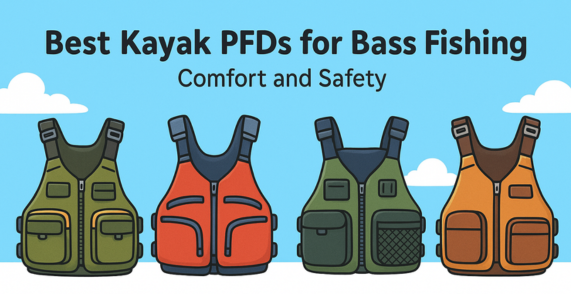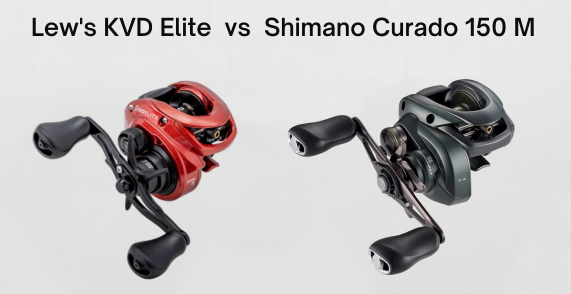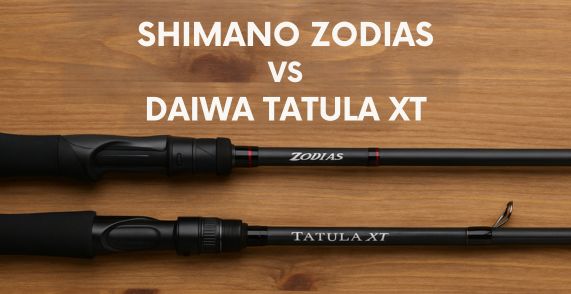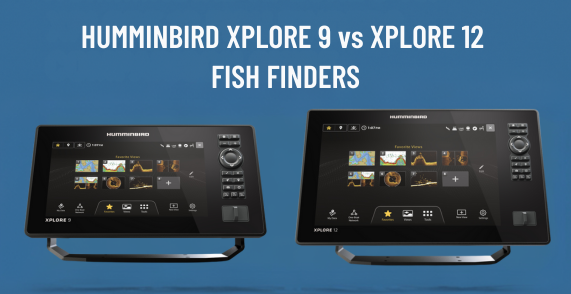In This Post
- 1 Key Takeaways
- 2 Life on the Line: Why Your PFD Choice Matters for Bass Fishing
- 3 Top-Rated PFDs Designed Specifically for Kayak Anglers
- 4 Which one to choose based on your requirements
- 5 Foam vs. Inflatable vs. Hybrid: Choosing Your Perfect PFD
- 6 Must-Have Features for Serious Bass Anglers
- 7 Getting the Perfect Fit: A Step-by-Step Guide
- 8 North American Regulations You Need to Know
- 9 PFD Maintenance: Extending the Life of Your Safety Equipment
- 10 Wear It Every Time: The Only PFD That Works Is the One You Have On
Key Takeaways
- The most effective kayak fishing PFD combines safety with comfort to ensure you’ll actually wear it consistently on the water
- High-back designs like the NRS Chinook and Astral V-Eight work specifically with modern fishing kayak seats
- Foam PFDs offer reliable, always-ready protection without requiring activation or maintenance
- Strategic pocket placement and tool attachment points keep essential gear accessible while fishing
- Fishing Zenith recommends proper fitting with 5-point adjustment to maximize both safety and all-day comfort
Life on the Line: Why Your PFD Choice Matters for Bass Fishing
Your life literally depends on wearing the right PFD when bass fishing from a kayak. Reaching for that trophy fish, standing to make the perfect cast, or simply navigating choppy waters can send you overboard in seconds—with zero time to grab safety gear.
At Fishing Zenith, we understand that the best PFD is one you’ll actually wear all day, every trip.
Unlike other fishing equipment where performance is the primary concern, a PFD’s effectiveness begins with comfort. Uncomfortable PFDs get removed or left at home, providing zero protection when you need it most.
The kayak bass angler faces unique challenges—sitting for hours against a seat back, making repetitive casting motions, and needing quick access to tackle and tools—all while staying safe on the water.
Modern fishing-specific PFDs have changed dramatically to address these needs. Most adults only need 7-12 pounds of buoyancy to stay afloat, while standard Type III/Level 70 PFDs provide at least 15.5 pounds—more than enough for most fishing scenarios.
This allows manufacturers to focus on creating comfortable, functional designs rather than simply maximizing flotation.
Top-Rated PFDs Designed Specifically for Kayak Anglers
1. NRS Chinook: The Gold Standard for Bass Anglers
The NRS Chinook consistently ranks as the top choice among serious bass anglers, and for good reason. This Type III PFD delivers 16.5 pounds of flotation while offering unmatched comfort and fishing-specific features. The high-back design works perfectly with modern kayak seats, preventing the uncomfortable bunching that makes anglers tempted to remove their PFDs.
What truly sets the Chinook apart is its thoughtful storage configuration:
- Two large front pockets perfectly sized for tackle boxes
- Dedicated tool holder pocket that keeps pliers within easy reach
- Rod holder loop that frees up your hands when retying or unhooking fish
- Reflective accents for improved visibility in low light conditions
- Mesh lower back panel that enhances ventilation on hot days
The Chinook’s PlushFit foam panels contour to your body, providing exceptional comfort even during all-day fishing trips. At just 2 pounds, it remains surprisingly lightweight despite its comprehensive feature set.
2. Astral V-Eight Fisher: Ultimate Ventilation for Hot Days
For bass anglers who fish primarily in hot weather, the Astral V-Eight Fisher addresses the most common complaint about PFDs: overheating. This innovative vest features Astral’s patented Airescape technology—a ventilation system that creates 70% less body contact than traditional PFDs.
The V-Eight’s design includes:
- Perforated foam panels that allow air circulation
- High-mesh back design that pairs perfectly with elevated kayak seats
- Strategic pocket placement for essential fishing tools
- Ultra-lightweight construction at just 1.37 pounds
The Astral excels in situations where heat management is your primary concern, making it ideal for summer bass fishing in southern waters.
3. Stohlquist Fisherman: Exceptional Comfort and Storage
The Stohlquist Fisherman has earned a devoted following among bass anglers who value comfort and organization.
This Type III PFD features seven strategically placed pockets, offering some of the most comprehensive storage options available in a fishing vest. Its thin back design works harmoniously with high kayak seat backs while maintaining the necessary safety standards.
Standout features of the Stohlquist include:
- Seven specialized pockets including handwarmer pockets for cold-weather fishing
- Durable 500-denier Cordura shell material that withstands years of hard use
- Comfortable cinch harness that prevents the vest from riding up
- Outstanding ventilation through mesh panels to keep you cool
Many professional guides choose the Stohlquist Fisherman as their daily PFD due to its exceptional durability and thoughtful design elements that cater specifically to the needs of serious anglers.
4. Onyx Kayak Fishing Vest: Best Budget Option
Proving that safety doesn’t have to break the bank, the Onyx Kayak Fishing Vest delivers solid performance at a price point typically under $80. This Type III PFD offers the essential features bass anglers need without unnecessary frills:
- High foam back that accommodates elevated kayak seats
- Six adjustment points for a secure, customized fit
- Multiple pocket options including a drop-down tackle tray
- Breathable mesh lower back for ventilation
- Durable 400-denier nylon construction
The breathable mesh lower back enhances comfort during long fishing sessions, while the six adjustment points ensure a secure, personalized fit.
The Onyx represents an excellent entry point for anglers looking to upgrade from recreational PFDs to fishing-specific designs without a significant investment.
Which one to choose based on your requirements
Selecting the right fishing PFD ultimately depends on your specific needs and fishing style:
- If you want the most comprehensive features and don’t mind spending more, the NRS Chinook offers the best overall package
- For hot weather fishing where ventilation is your top priority, choose the Astral V-Eight Fisher
- If you carry lots of tackle and fish in various weather conditions, the Stohlquist Fisherman’s seven pockets make it ideal
- For anglers on a budget who still want fishing-specific features, the Onyx Kayak Fishing Vest delivers excellent value
Foam vs. Inflatable vs. Hybrid: Choosing Your Perfect PFD
Foam PFDs: Always-Ready Protection
Foam PFDs remain the gold standard for kayak fishing safety, especially for solo anglers. These vests provide immediate, inherent buoyancy without requiring any activation.
The moment you hit the water—whether planned or unexpected—a foam PFD is already working. This reliability makes foam the preferred choice for most kayak bass fishing scenarios.
Beyond reliability, foam PFDs offer practical advantages for anglers. Their stable structure provides an ideal platform for pockets and attachment points that keep fishing essentials organized and accessible.
They also provide some thermal insulation during cool weather and require minimal maintenance beyond basic inspections for wear and tear.
The primary drawbacks are bulk and heat retention. Foam PFDs are inherently thicker and can restrict movement during aggressive casting.
They also trap body heat, which becomes problematic during summer fishing. Modern designs with sculpted foam panels and ventilation systems have significantly improved these issues, but they remain considerations when selecting your ideal PFD.
Inflatable PFDs: Slim but High-Maintenance
Inflatable PFDs offer unmatched comfort when uninflated, with sleek designs that barely feel present on your body.
This ultra-low profile allows complete freedom of movement for casting and paddling. When activated, they typically provide higher buoyancy ratings (22-38 pounds) than standard foam vests.
Inflatable PFDs come in two primary variations: manual and automatic. Manual versions require pulling a cord to trigger inflation, while automatic models deploy upon water immersion.
Both systems rely on CO2 cartridges that must be replaced after each deployment.
The significant drawbacks make inflatables problematic for most kayak bass fishing scenarios. They provide zero flotation until activated, creating a critical vulnerability if you’re unconscious during entry into the water.
They require regular maintenance to ensure proper function, including cartridge inspections and bladder checks. They also offer minimal storage options for fishing gear and are generally not recommended for frequent water contact activities like kayaking.
Hybrid PFDs: The Best of Both Worlds
Hybrid PFDs represent a middle ground, combining inherent foam flotation with supplemental inflatable chambers.
Models like the Mustang Khimera provide baseline buoyancy (typically 7-8 pounds) from their foam structure, with the option to manually inflate an additional chamber for maximum flotation when needed.
This design delivers immediate protection with a significantly lower profile than traditional foam vests.
The result is enhanced comfort and mobility while maintaining baseline safety. The manual inflation component means you control when to deploy the maximum buoyancy, avoiding unwanted automatic deployments during water splashes or rain.
Hybrids do require more maintenance than foam-only options but less than pure inflatables. They represent an excellent balance for experienced anglers who value comfort but understand the importance of inherent flotation for kayak fishing safety.
Must-Have Features for Serious Bass Anglers
1. High-Back Design for Modern Kayak Seats
Modern fishing kayaks typically feature elevated, lawn-chair style seats that place the angler higher above the water for improved visibility and casting leverage.
Standard PFDs with full-back foam panels create an uncomfortable interface with these seats, pushing the vest upward and creating pressure points against the neck and shoulders.
A high-back design (sometimes called a “thin back” or “mesh back”) eliminates this conflict. These PFDs feature either reduced foam or mesh panels in the lower back area, allowing them to sit comfortably against high kayak seat backs without riding up.
This seemingly simple design consideration dramatically improves all-day comfort and significantly increases the likelihood you’ll keep your PFD on throughout your fishing session.
2. Strategic Pocket Configuration
Thoughtful pocket design transforms a PFD from simple safety device to functional fishing tool. The most useful configurations include multiple pocket types:
- Large clamshell pockets for tackle boxes and bulkier items
- Tool-specific holders for pliers, line cutters, and fishing tools
- Fleece-lined handwarmer pockets for early morning or cool weather comfort
- Secure zippered pockets for phones, keys, and valuable items
- Drop-down tray pockets with internal organization for small terminal tackle
The key is strategic placement rather than maximum capacity. Overloading your PFD with heavy gear compromises both comfort and flotation effectiveness. Focus on keeping essential, frequently-used items in your PFD pockets while storing heavier gear elsewhere on your kayak.
3. Tool Attachment Points and Rod Holders
Beyond pockets, dedicated attachment points for fishing tools dramatically improve on-water efficiency. Look for PFDs that include these functional elements:
- Lash tabs for securing knives or other tools with sheaths
- D-rings for attaching retractable tool lanyards
- Elastic webbing for temporary tool storage
- Rod holder loops for hands-free management while rigging or handling fish
These features eliminate frustrating searches for tools when you need them most, like when you’re controlling a fish with one hand and need your pliers with the other. The best fishing PFDs integrate these attachment points in intuitive locations that become second nature after a few trips.
4. Ventilation Systems for All-Day Comfort
Heat management is crucial for PFD compliance in warm weather. Advanced ventilation systems transform what would be a sweltering experience into all-day comfort. Look for these cooling features:
- Mesh panels on the back and sides for increased airflow
- Perforated foam that allows heat and moisture to escape
- Wicking fabrics that pull sweat away from your body
- Minimalist designs that reduce body contact surface area
The Astral V-Eight’s Airescape technology represents the pinnacle of this approach, combining ventilation holes and breathable materials to reduce the signature “PFD sauna effect” that causes many anglers to remove their vests in hot weather.
5. Visibility Elements for Safety
While not strictly a fishing function, visibility features play a critical safety role. Bright colors (orange, yellow, red) make you more visible to other boaters, while reflective elements enhance visibility in low light.
These passive safety features require no action on your part but provide significant protection in busy waterways or during emergency situations.
Getting the Perfect Fit: A Step-by-Step Guide
The 5-Point Adjustment Process
A properly fitted PFD should feel like an extension of your body—secure without restriction. Follow this systematic process to achieve an ideal fit:
- Start loose: Put on the PFD with all straps fully loosened
- Secure the entry: Zip or buckle the main closure system
- Bottom up: Tighten the waistband first to anchor the PFD in position
- Side adjustments: Evenly tighten side straps, working from bottom to top
- Shoulder finalization: Adjust shoulder straps last to prevent the vest from riding up
Take your time with this process. A rushed fitting often results in an uncomfortable PFD that you’ll be tempted to remove. Most PFDs will feel somewhat stiff when brand new; many will break in and become more comfortable after several uses.
Testing Your Fit on Land and Water
Before heading out, perform these simple tests to verify your PFD fit:
- The pull-up test: Have someone pull up on the shoulders of your PFD. If it rises past your nose or can be pulled over your head, tighten the straps or try a smaller size.
- The movement test: Simulate fishing motions like casting and paddling. The PFD should move with you without significant riding up or chafing.
- The breathing test: Take several deep breaths. The PFD should allow full chest expansion without restriction.
Once on the water, perform a controlled float test in shallow water. With your PFD properly fitted, bend your knees to float. The PFD should keep your head comfortably above water without riding up or shifting position.
North American Regulations You Need to Know
PFD regulations have recently changed as North American standards harmonize. The old USCG “Type” classification system (Types I-V) is being replaced with a simpler, more intuitive “Level” system that aligns with international standards:
- Level 50: Basic flotation for calm, protected waters with quick rescue
- Level 70: Standard for most recreational activities (equivalent to old Type III)
- Level 100+: Enhanced flotation and turning capability for rough waters
For kayak bass fishing, a Level 70 (formerly Type III) PFD is ideal, offering the right balance of buoyancy (minimum 15.5 pounds) and mobility.
These devices are designed for conscious wearers in calm to moderate conditions where quick rescue is likely—precisely the scenario for most bass fishing environments.
Both U.S. and Canadian regulations require that each person on a kayak have an approved PFD of the correct size.
While wearing it isn’t always legally mandated for adults (though strongly recommended), most jurisdictions require children to wear PFDs at all times. Some regions also have seasonal wear requirements during cold-weather months.
The most important regulatory consideration is approval marking. Your PFD must carry either a USCG approval label or, with the new harmonized standards, a UL marking indicating compliance with the appropriate level.
For cross-border anglers, choosing a PFD with dual certification ensures compliance in both U.S. and Canadian waters.
PFD Maintenance: Extending the Life of Your Safety Equipment
Daily Inspection Routine
Develop the habit of quick pre-launch inspections:
- Visual check: Look for rips, tears, or damaged straps
- Hardware test: Ensure all buckles, zippers, and fasteners work properly
- Buoyancy assessment: Check for compression or damaged foam
- Inflatable check: For hybrid or inflatable PFDs, verify green indicators and properly installed CO2 cartridges
This 30-second ritual can identify problems before they become safety issues. A damaged PFD is not legally compliant and may not function properly during an emergency.
Cleaning and Storage Best Practices
Proper care significantly extends your PFD’s lifespan:
- Rinse after use: Always rinse with fresh water after fishing, especially after saltwater exposure
- Gentle cleaning: Use mild soap and water for deeper cleaning; avoid harsh chemicals
- Air dry completely: Allow thorough drying before storage to prevent mildew
- Store properly: Keep in a cool, dry place away from direct sunlight
- Never compress: Don’t use your PFD as a cushion or kneel on it in your kayak
Wear It Every Time: The Only PFD That Works Is the One You Have On
The statistics are sobering: 86% of drowning victims in boating accidents weren’t wearing PFDs, even though they were often available on the vessel.
This single fact underlies everything discussed about comfort, features, and design. The most advanced, highest-rated PFD provides zero protection if it’s stowed in a hatch or left at home.
Choose a PFD that balances safety with the comfort and features that ensure you’ll actually wear it. Consider your specific fishing style, body type, and the waters you frequent. Invest in quality, as this is genuinely life-saving equipment.
Whether you select the feature-rich NRS Chinook, the ventilated Astral V-Eight, the comfortable Stohlquist Fisherman, or the budget-friendly Onyx Kayak Fishing Vest, make the commitment to wear it every time you’re on the water.
Your life is worth far more than any fish, and the right PFD ensures you’ll be around to catch many more.







